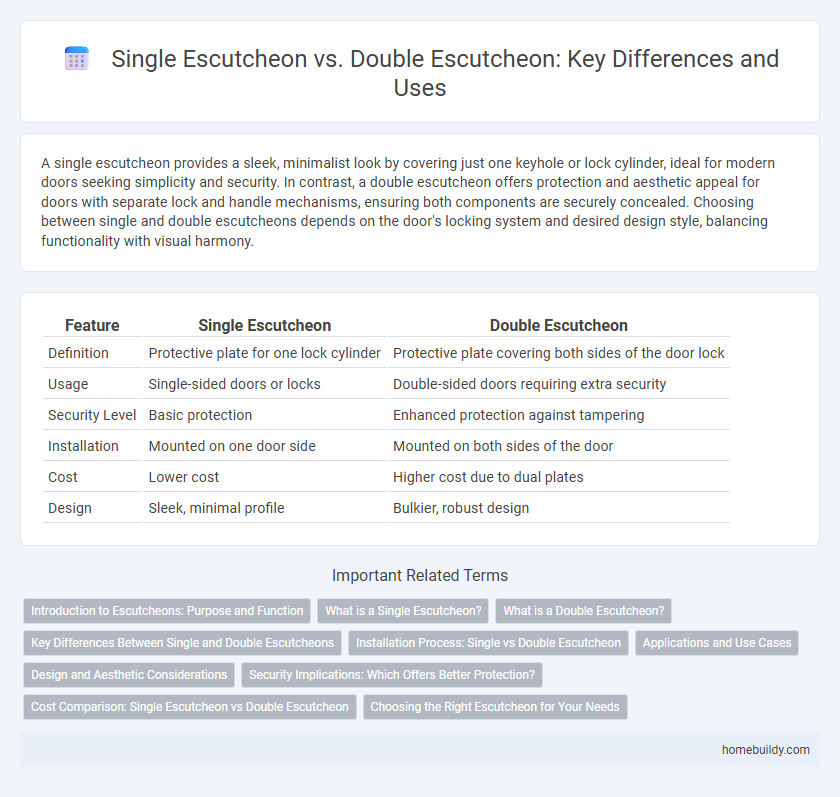A single escutcheon provides a sleek, minimalist look by covering just one keyhole or lock cylinder, ideal for modern doors seeking simplicity and security. In contrast, a double escutcheon offers protection and aesthetic appeal for doors with separate lock and handle mechanisms, ensuring both components are securely concealed. Choosing between single and double escutcheons depends on the door's locking system and desired design style, balancing functionality with visual harmony.
Table of Comparison
| Feature | Single Escutcheon | Double Escutcheon |
|---|---|---|
| Definition | Protective plate for one lock cylinder | Protective plate covering both sides of the door lock |
| Usage | Single-sided doors or locks | Double-sided doors requiring extra security |
| Security Level | Basic protection | Enhanced protection against tampering |
| Installation | Mounted on one door side | Mounted on both sides of the door |
| Cost | Lower cost | Higher cost due to dual plates |
| Design | Sleek, minimal profile | Bulkier, robust design |
Introduction to Escutcheons: Purpose and Function
A single escutcheon is a protective plate designed to surround and shield a single keyhole or lock cylinder, preventing damage and enhancing security. Double escutcheons serve the same purpose but cover two keyholes or cylinders, often found on doors with dual locking mechanisms for increased safety. Both types act as decorative elements while providing a durable barrier against tampering and environmental wear.
What is a Single Escutcheon?
A single escutcheon is a protective plate designed to cover and reinforce a keyhole or lock cylinder, enhancing both security and aesthetics. It typically accommodates one lock mechanism, providing a streamlined and minimalistic appearance on doors. Commonly made from metal materials like brass, stainless steel, or aluminum, single escutcheons help prevent tampering and protect the lock from environmental damage.
What is a Double Escutcheon?
A double escutcheon features two overlapping or adjacent plates designed to provide enhanced protection and aesthetic appeal for door locks and handles. It offers increased security by accommodating both the keyhole and the handle spindle, often used in doors requiring additional reinforcement. Compared to a single escutcheon, a double escutcheon covers more hardware components, ensuring better durability and visual symmetry.
Key Differences Between Single and Double Escutcheons
Single escutcheons feature one keyhole or lock cylinder opening, ideal for doors with a single locking mechanism, while double escutcheons accommodate two openings, supporting both a keyhole and a thumb turn or dual lock systems. Material composition, design complexity, and installation vary, with double escutcheons often requiring more precise alignment and offering enhanced security options. The choice depends on door functionality, security requirements, and aesthetic preferences, with single escutcheons suited for simpler locks and double escutcheons designed for multi-point locking solutions.
Installation Process: Single vs Double Escutcheon
Single escutcheons simplify the installation process with fewer mounting points, requiring less alignment and minimal adjustments, making them ideal for straightforward door setups. Double escutcheons demand precise alignment of inner and outer plates, often necessitating additional hardware and meticulous measurement to ensure proper fit and aesthetics. Choosing between single and double escutcheon installations impacts time, complexity, and the tools needed, with double escutcheons typically requiring more advanced skills and attention to detail.
Applications and Use Cases
Single escutcheons are commonly used in residential settings to cover a single keyhole or lock mechanism, providing a clean and secure appearance for doors and cabinets. Double escutcheons are preferred in applications requiring dual keyholes for additional security or aesthetic balance, such as in entry doors or antique furniture with both a lock and a thumb turn. The choice between single and double escutcheons depends on functional needs and decorative preferences, with double escutcheons offering enhanced protection and symmetrical design in more complex locking systems.
Design and Aesthetic Considerations
Single escutcheons feature a minimalist design that emphasizes sleek lines and subtle detailing, making them ideal for modern or understated aesthetics. Double escutcheons incorporate paired plates around keyholes or locks, offering a balanced and symmetrical look that enhances traditional or ornate door styles. Selecting between single and double escutcheons depends on the desired visual impact, door hardware compatibility, and the overall architectural theme.
Security Implications: Which Offers Better Protection?
Single escutcheons provide basic protection by covering keyholes and preventing tampering, but double escutcheons enhance security by incorporating an additional locking mechanism or protective plate. Double escutcheons reduce vulnerability to lock picking and drilling attacks, making them more suitable for high-security applications. Choosing between single and double escutcheons depends on the required security level, with double options offering superior defense against forced entry.
Cost Comparison: Single Escutcheon vs Double Escutcheon
Single escutcheons generally cost less than double escutcheons due to their simpler design and fewer materials required. Double escutcheons, accommodating two connections or hardware components, typically incur higher manufacturing and installation costs. Budget considerations often favor single escutcheons for basic setups, while double escutcheons provide added functionality but at an increased price point.
Choosing the Right Escutcheon for Your Needs
Selecting the right escutcheon depends on your specific security and aesthetic requirements. A single escutcheon typically provides basic protection around a door lock, ideal for standard residential use, while a double escutcheon offers enhanced security by covering both sides of the door, suitable for commercial or high-security environments. Consider factors such as door type, lock compatibility, and desired level of defense to make an informed choice between single and double escutcheons.
Single Escutcheon vs Double Escutcheon Infographic

 homebuildy.com
homebuildy.com